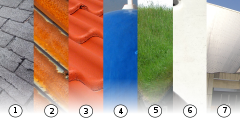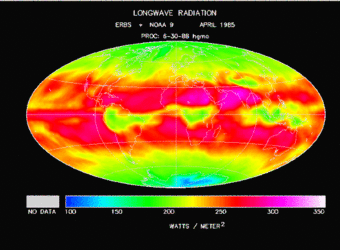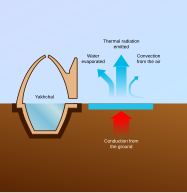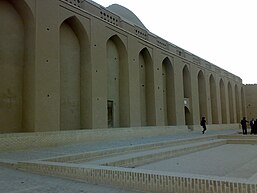Astronomy:Radiative cooling
In the study of heat transfer, radiative cooling[1][2] is the process by which a body loses heat by thermal radiation. As Planck's law describes, every physical body spontaneously and continuously emits electromagnetic radiation.
Radiative cooling has been applied in various contexts throughout human history, including ice making in India and Iran,[3] heat shields for spacecraft,[4] and in architecture.[5] In 2014, a scientific breakthrough in the use of photonic metamaterials made daytime radiative cooling possible.[6][7] It has since been proposed as a strategy to mitigate local and global warming caused by greenhouse gas emissions known as passive daytime radiative cooling.[8]
Terrestrial radiative cooling
Mechanism
Infrared radiation can pass through dry, clear air in the wavelength range of 8–13 µm. Materials that can absorb energy and radiate it in those wavelengths exhibit a strong cooling effect. Materials that can also reflect 95% or more of sunlight in the 200 nanometres to 2.5 µm range can exhibit cooling even in direct sunlight.[9]
Earth's energy budget
The Earth-atmosphere system is radiatively cooled, emitting long-wave (infrared) radiation which balances the absorption of short-wave (visible light) energy from the sun.
Convective transport of heat, and evaporative transport of latent heat are both important in removing heat from the surface and distributing it in the atmosphere. Pure radiative transport is more important higher up in the atmosphere. Diurnal and geographical variation further complicate the picture.
The large-scale circulation of the Earth's atmosphere is driven by the difference in absorbed solar radiation per square meter, as the sun heats the Earth more in the Tropics, mostly because of geometrical factors. The atmospheric and oceanic circulation redistributes some of this energy as sensible heat and latent heat partly via the mean flow and partly via eddies, known as cyclones in the atmosphere. Thus the tropics radiate less to space than they would if there were no circulation, and the poles radiate more; however in absolute terms the tropics radiate more energy to space.
Nocturnal surface cooling
Radiative cooling is commonly experienced on cloudless nights, when heat is radiated into outer space from Earth's surface, or from the skin of a human observer. The effect is well-known among amateur astronomers.
The effect can be experienced by comparing skin temperature from looking straight up into a cloudless night sky for several seconds, to that after placing a sheet of paper between the face and the sky. Since outer space radiates at about a temperature of 3 K (−270.15 °C; −454.27 °F), and the sheet of paper radiates at about 300 K (27 °C; 80 °F) (around room temperature), the sheet of paper radiates more heat to the face than does the darkened cosmos. The effect is blunted by Earth's surrounding atmosphere, and particularly the water vapor it contains, so the apparent temperature of the sky is far warmer than outer space. The sheet does not block the cold, but instead reflects heat to the face and radiates the heat of the face that it just absorbed.
The same radiative cooling mechanism can cause frost or black ice to form on surfaces exposed to the clear night sky, even when the ambient temperature does not fall below freezing.
Kelvin's estimate of the Earth's age
The term radiative cooling is generally used for local processes, though the same principles apply to cooling over geological time, which was first used by Kelvin to estimate the age of the Earth (although his estimate ignored the substantial heat released by radioisotope decay, not known at the time, and the effects of convection in the mantle).
Astronomy
Radiative cooling is one of the few ways an object in space can give off energy. In particular, white dwarf stars are no longer generating energy by fusion or gravitational contraction, and have no solar wind. So the only way their temperature changes is by radiative cooling. This makes their temperature as a function of age very predictable, so by observing the temperature, astronomers can deduce the age of the star.[10][11]
Applications
Climate change
The widespread application of passive daytime radiative cooling (PDRC) technologies that use the infrared window (8–13 µm) to dissipate heat through longwave infrared (LWIR) thermal radiation heat transfer with outer space,[12] has been proposed as a method of reducing temperature increases caused by climate change. The installation of passive radiative heat emission technologies has been proposed as necessary to lower the temperature of Earth at a fast enough rate for human survivability.[13] Munday summarized the global implementation of such technologies:
Currently the Earth is absorbing ~1 W/m2 more than it is emitting, which leads to an overall warming of the climate. By covering the Earth with a small fraction of thermally emitting materials, the heat flow away from the Earth can be increased, and the net radiative flux can be reduced to zero (or even made negative), thus stabilizing (or cooling) the Earth (...) If only 1%–2% of the Earth’s surface were instead made to radiate at this rate rather than its current average value, the total heat fluxes into and away from the entire Earth would be balanced and warming would cease.[13]
PDRCs mimic the natural process of radiative cooling, in which the Earth cools itself by releasing heat to outer space (Earth's energy budget), although during the daytime, lowering ambient temperatures under direct solar intensity.[14] On a clear day, solar irradiance can reach 1000 W/m2 with a diffuse component between 50-100 W/m2. The average PDRC has an estimated cooling power of ~100-150 W/m2.[15] The cooling power of PDRCs is proportional to the exposed surface area of the installation.[16]
Architecture

Cool roofs combine high solar reflectance with high infrared emittance, thereby simultaneously reducing heat gain from the sun and increasing heat removal through radiation. Radiative cooling thus offers potential for passive cooling for residential and commercial buildings.[5] Traditional building surfaces, such as paint coatings, brick and concrete have high emittances of up to 0.96.[17] They radiate heat into the sky to passively cool buildings at night. If made sufficiently reflective to sunlight, these materials can also achieve radiative cooling during the day.
The most common radiative coolers found on buildings are white cool-roof paint coatings, which have solar reflectances of up to 0.94, and thermal emittances of up to 0.96.[18] The solar reflectance of the paints arises from optical scattering by the dielectric pigments embedded in the polymer paint resin, while the thermal emittance arises from the polymer resin. However, because typical white pigments like titanium dioxide and zinc oxide absorb ultraviolet radiation, the solar reflectances of paints based on such pigments do not exceed 0.95.
In 2014, researchers developed the first daytime radiative cooler using a multi-layer thermal photonic structure that selectively emits long wavelength infrared radiation into space, and can achieve 5 °C sub-ambient cooling under direct sunlight.[19] Later researchers developed paintable porous polymer coatings, whose pores scatter sunlight to give solar reflectance of 0.96-0.99 and thermal emittance of 0.97.[20] In experiments under direct sunlight, the coatings achieve 6 °C sub-ambient temperatures and cooling powers of 96 W/m2.
Other notable radiative cooling strategies include dielectric films on metal mirrors,[21] and polymer or polymer composites on silver or aluminum films.[22] Silvered polymer films with solar reflectances of 0.97 and thermal emittance of 0.96, which remain 11 °C cooler than commercial white paints under the mid-summer sun, were reported in 2015.[23] Researchers explored designs with dielectric silicon dioxide or silicon carbide particles embedded in polymers that are translucent in the solar wavelengths and emissive in the infrared.[24][25] In 2017, an example of this design with resonant polar silica microspheres randomly embedded in a polymeric matrix, was reported.[26] The material is translucent to sunlight and has infrared emissivity of 0.93 in the infrared atmospheric transmission window. When backed with silver coating, the material achieved a midday radiative cooling power of 93 W/m2 under direct sunshine along with high-throughput, economical roll-to-roll manufacturing.
Heat shields
High emissivity coatings that facilitate radiative cooling may be used in reusable thermal protection systems (RTPS) in spacecraft and hypersonic aircraft. In such heat shields a high emissivity material, such as molybdenum disilicide (MoSi2) is applied on a thermally insulating ceramic substrate.[4] In such heat shields high levels of total emissivity, typically in the range 0.8 - 0.9, need to be maintained across a range of high temperatures. Planck's law dictates that at higher temperatures the radiative emission peak shifts to lower wavelengths (higher frequencies), influencing material selection as a function of operating temperature. In addition to effective radiative cooling, radiative thermal protection systems should provide damage tolerance and may incorporate self-healing functions through the formation of a viscous glass at high temperatures.
James Webb Space Telescope
The James Webb Space Telescope uses radiative cooling to reach its operation temperature of about 50 K. To do this, its large reflective sunshield blocks radiation from the Sun, Earth, and Moon. The telescope structure, kept permanently in shadow by the sunshield, then cools by radiation.
Nocturnal ice making in early India and Iran
Before the invention of artificial refrigeration technology, ice making by nocturnal cooling was common in both India and Iran.
In India, such apparatus consisted of a shallow ceramic tray with a thin layer of water, placed outdoors with a clear exposure to the night sky. The bottom and sides were insulated with a thick layer of hay. On a clear night the water would lose heat by radiation upwards. Provided the air was calm and not too far above freezing, heat gain from the surrounding air by convection was low enough to allow the water to freeze.[27][28][3]
In Iran, this involved making a large flat ice pools, which consisted of a reflection pool of water built on a bed of highly insulative material surrounded by high walls. The high walls provided protection against convective warming, the insulative material of the pool walls would protect against conductive heating from the ground, the large flat plane of water would then permit evaporative and radiative cooling to take place.
See also
- Heat shield
- Optical solar reflector, used for thermal control of spacecraft
- Passive cooling
- Radiative forcing
- Stefan–Boltzmann law
- Terrestrial albedo effect
- Urban heat island
- Urban thermal plume
References
- ↑ Fan, Shanhui; Li, Wei (March 2022). "Photonics and thermodynamics concepts in radiative cooling". Nature Photonics 16 (3): 182–190. doi:10.1038/s41566-021-00921-9. Bibcode: 2022NaPho..16..182F.
- ↑ Li, Wei; Fan, Shanhui (1 November 2019). "Radiative Cooling: Harvesting the Coldness of the Universe". Optics and Photonics News 30 (11): 32. doi:10.1364/OPN.30.11.000032. Bibcode: 2019OptPN..30...32L.
- ↑ Jump up to: 3.0 3.1 "The Persian ice house, or how to make ice in the desert". 2016-04-04. https://www.fieldstudyoftheworld.com/persian-ice-house-how-make-ice-desert/.
- ↑ Jump up to: 4.0 4.1 Shao, Gaofeng (2019). "Improved oxidation resistance of high emissivity coatings on fibrous ceramic for reusable space systems". Corrosion Science 146: 233–246. doi:10.1016/j.corsci.2018.11.006.
- ↑ Jump up to: 5.0 5.1 Hossain, Md Muntasir; Gu, Min (2016-02-04). "Radiative cooling: Principles, progress and potentials". Advanced Science 3 (7): 1500360. doi:10.1002/advs.201500360. PMID 27812478.
- ↑ Heo, Se-Yeon; Ju Lee, Gil; Song, Young Min (June 2022). "Heat-shedding with photonic structures: radiative cooling and its potential". Journal of Materials Chemistry C 10 (27): 9915–9937. doi:10.1039/D2TC00318J. https://pubs.rsc.org/en/content/articlelanding/2022/tc/d2tc00318j.
- ↑ Raman, Aaswath P.; Anoma, Marc Abou; Zhu, Linxiao; Raphaeli, Eden; Fan, Shanhui (2014). "Passive Radiative Cooling Below Ambient air Temperature under Direct Sunlight". Nature 515 (7528): 540–544. doi:10.1038/nature13883. PMID 25428501. Bibcode: 2014Natur.515..540R. https://www.nature.com/articles/nature13883.
- ↑ Munday, Jeremy (2019). "Tackling Climate Change through Radiative Cooling". Joule 3 (9): 2057–2060. doi:10.1016/j.joule.2019.07.010.
- ↑ Lim, XiaoZhi (2019-12-31). "The super-cool materials that send heat to space". Nature 577 (7788): 18–20. doi:10.1038/d41586-019-03911-8. PMID 31892746.
- ↑ Mestel, L. (1952). "On the theory of white dwarf stars. I. The energy sources of white dwarfs". Monthly Notices of the Royal Astronomical Society 112 (6): 583–597. doi:10.1093/mnras/112.6.583. Bibcode: 1952MNRAS.112..583M.
- ↑ "Cooling white dwarfs". Physics Department, University of Patras. http://old.physics.upatras.gr/UploadedFiles/course_149_4311.pdf.
- ↑ Chen, Jianheng; Lu, Lin; Gong, Quan (June 2021). "A new study on passive radiative sky cooling resource maps of China". Energy Conversion and Management 237: 114132. doi:10.1016/j.enconman.2021.114132. https://www.sciencedirect.com/science/article/abs/pii/S0196890421003083. "Passive radiative cooling utilizes atmospheric transparency window (8–13 µm) to discharge heat into outer space and inhibits solar absorption.".
- ↑ Jump up to: 13.0 13.1 Munday, Jeremy (2019). "Tackling Climate Change through Radiative Cooling". Joule 3 (9): 2057–2060. doi:10.1016/j.joule.2019.07.010.
- ↑ Aili, Ablimit; Yin, Xiaobo; Yang, Ronggui (October 2021). "Global Radiative Sky Cooling Potential Adjusted for Population Density and Cooling Demand". Atmosphere 12 (11): 1379. doi:10.3390/atmos12111379.
- ↑ Chen, Meijie; Pang, Dan; Chen, Xingyu; Yan, Hongjie; Yang, Yuan (2022). "Passive daytime radiative cooling: Fundamentals, material designs, and applications". EcoMat 4. doi:10.1002/eom2.12153. https://onlinelibrary.wiley.com/doi/pdf/10.1002/eom2.12153.
- ↑ Heo, Se-Yeon; Ju Lee, Gil; Song, Young Min (June 2022). "Heat-shedding with photonic structures: radiative cooling and its potential". Journal of Materials Chemistry C 10 (27): 9915–9937. doi:10.1039/D2TC00318J. https://pubs.rsc.org/en/content/articlelanding/2022/tc/d2tc00318j.
- ↑ "Emissivity Coefficients Materials". https://www.engineeringtoolbox.com/emissivity-coefficients-d_447.html.
- ↑ "Find rated products – Cool Roof Rating Council". https://coolroofs.org/directory.
- ↑ Raman, Aaswath P.; Anoma, Marc Abou; Zhu, Linxiao; Rephaeli, Eden; Fan, Shanhui (November 2014). "Passive radiative cooling below ambient air temperature under direct sunlight". Nature 515 (7528): 540–544. doi:10.1038/nature13883. PMID 25428501. Bibcode: 2014Natur.515..540R.
- ↑ Mandal, Jyotirmoy; Fu, Yanke; Overvig, Adam; Jia, Mingxin; Sun, Kerui; Shi, Norman Nan; Yu, Nanfang; Yang, Yuan (19 October 2018). "Hierarchically porous polymer coatings for highly efficient passive daytime radiative cooling". Science 362 (6412): 315–319. doi:10.1126/science.aat9513. PMID 30262632. Bibcode: 2018Sci...362..315M.
- ↑ Granqvist, C. G.; Hjortsberg, A. (June 1981). "Radiative cooling to low temperatures: General considerations and application to selectively emitting SiO films". Journal of Applied Physics 52 (6): 4205–4220. doi:10.1063/1.329270. Bibcode: 1981JAP....52.4205G.
- ↑ Grenier, Ph. (January 1979). "Réfrigération radiative. Effet de serre inverse". Revue de Physique Appliquée 14 (1): 87–90. doi:10.1051/rphysap:0197900140108700. https://hal.archives-ouvertes.fr/jpa-00244594/document.
- ↑ Gentle, Angus R.; Smith, Geoff B. (September 2015). "A Subambient Open Roof Surface under the Mid-Summer Sun". Advanced Science 2 (9): 1500119. doi:10.1002/advs.201500119. PMID 27980975.
- ↑ Gentle, A. R.; Smith, G. B. (2010-02-10). "Radiative Heat Pumping from the Earth Using Surface Phonon Resonant Nanoparticles". Nano Letters 10 (2): 373–379. doi:10.1021/nl903271d. PMID 20055479. Bibcode: 2010NanoL..10..373G.
- ↑ Yu, Nanfang; Mandalal, Jyotirmoy; Overvig, Adam and Shi, Norman Nan, "Systems and methods for radiative cooling and heating", WO patent 2016205717A1, issued 2016-06-17
- ↑ Zhai, Yao; Ma, Yaoguang; David, Sabrina N.; Zhao, Dongliang; Lou, Runnan; Tan, Gang; Yang, Ronggui; Yin, Xiaobo (2017-03-10). "Scalable-manufactured randomized glass-polymer hybrid metamaterial for daytime radiative cooling". Science 355 (6329): 1062–1066. doi:10.1126/science.aai7899. PMID 28183998. Bibcode: 2017Sci...355.1062Z.
- ↑ "Lesson 1: History Of Refrigeration, Version 1 ME". Indian Institute of Technology Kharagpur. http://nptel.iitm.ac.in/courses/Webcourse-contents/IIT%20Kharagpur/Ref%20and%20Air%20Cond/pdf/RAC%20%20Lecture%201.pdf.
- ↑ "XXII. The process of making ice in the East Indies. By Sir Robert Barker, F. R. S. in a letter to Dr. Brocklesby". Philosophical Transactions of the Royal Society of London 65: 252–257. 1997. doi:10.1098/rstl.1775.0023.
 |





